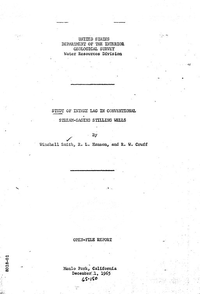This study investigated the relation between lag, or head loss (hL), in a typical stilling-well intake system of a stream-gaging station and rate of change of stage (ΔH/Δt) of the stream. The purpose of the study was to define such a relation in general terms and thus provide a rational procedure for intake design. The relation between head loss and rate change of stage was determined by isolating the effects of the various components in the intake system, so that equations could be derived that enable one to compute the head loss in an intake system composed of any combination of these components. In the derivation of the equations steady-state flow conditions were assumed, and the components considered were those most commonly used in Geological Survey gaging stations--static tubes, 3-way steamcock valvles, and side-outlet tees.


